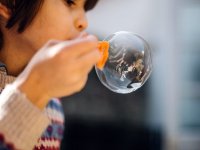The Adolescent Brain: Leaving Childhood Behind
In her final post about the film “Inside Out,” Lori Desautels suggests how educators can ease adolescent students’ transition as their maturing brains redefine purpose and identity.
Your content has been saved!
Go to My Saved Content.There isn't a more profound scene in the film Inside Out than the death of Bing Bong, Riley’s imaginary friend. As the main character approaches her 12th birthday, her brain is beginning to develop in ways that leave her imagination behind. This is the time when children between the ages of 10 and 14 begin dying to their childhoods to be born into their adolescence.
Redefined Purpose and Identity
Bing Bong represents innocence, imagination, creativity, and childlike joy mixed with love. This is the second greatest time of brain change, the first being birth to three years of age. Inside Out embraces this development in a very visual and meaningful way as Bing Bong intentionally jumps out of the rainbow wagon, watching Joy return to headquarters without the weight of childhood thought processes and feelings. As Riley's brain begins exploring this adolescent stage of life, she begins searching for a new identity and social status, is confronted with intense emotions, and revisits many of her childhood core memories that begin to enrich this new developmental time in her life. Finding a new purpose and discovering who we are becoming characterize the great neurobiological changes that educators and parents need to deeply understand in this time of brain development.
The adolescent's jobs are to question authority and search for an identity. As young people grow into these new responsibilities mandated by their personal development, their teachers and administrators need to understand how to create classroom cultures and relationships that promote creativity, as well as positive social interactions that play into the intense emotions which are an integral part of the adolescent brain. It is our responsibility to help our young adults see a bigger life picture filled with optimal choices and consequences, so that embracing hindsight provides foresight for these genius chaotic minds.
There are also significant changes in the secretion and baseline levels of neurohormones. The adolescent brain contains lower levels of serotonin, which declines in these years. This can contribute to increased aggression along with higher levels of testosterone, which can also contribute to angry outbursts and impulsive behavior. The baseline for dopamine, our feel-good neurotransmitter, is also lower, so more dopamine is required for a satisfying result. Additionally, we know that the frontal lobes of the brain are not fully developed in these years, which limits brain function in problem solving, discernment, emotional regulation, and sustained attention.
Easing the Transition
There are many brain-aligned strategies that strengthen the creativity and productivity of young adults as we emotionally attach to our adolescents securing a safe environment for them to explore, identify, and connect with one another. Below are some questions that open the frontal lobe for connection, memory, and metacognition:
- What or who was your Bing Bong? Could it be an object (like a blanket or teddy bear) or something abstract?
- What does Bing Bong symbolize?
- Why is it important for Riley to let go of Bing Bong?
- Why did Bing Bong jump off the wagon?
- What makes it so sad for the audience (especially parents and adults) as we watch this part?
- Do we really ever lose Bing Bong? Explain.
- Do you have a core memory of an experience from your imagination? What is it like?
In The Teen Years Explained: A Guide to Healthy Adolescent Development, researchers from Johns Hopkins University provide a powerful handbook to better understanding the adolescent brain and how we can prepare to sit beside these young adults in a time when the brain is hot, messy, and beautifully intelligent and complex.
What can we do as educators to ease the transition into healthy adolescence?
- TeenMentalHealth.org's Teen Brain
- SciShow's The Teenage Brain Explained
As Urie Bronfenbenner said, "Every child needs at least one adult who is irrationally crazy about him or her." This is the kind of support that adolescents require, too. How do you demonstrate understanding and guidance for your students during this challenging phase of their lives?
